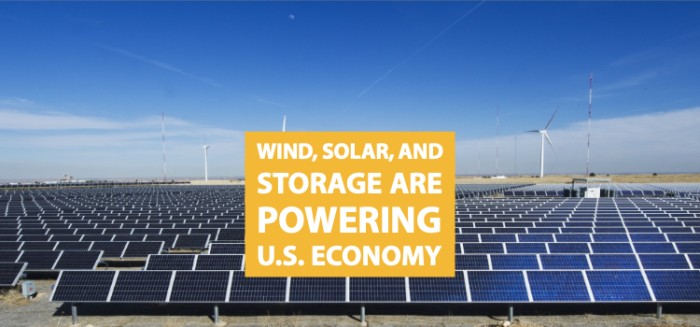Wind, Solar and Storage Are Powering US Economy
 | Isak Kvam, Communications / Policy Associate |

 | Isak Kvam, Communications / Policy Associate |
The US economy revved its engine in 2018, and renewable energy is powering alongside. The 2019 Factbook from the Business Council for Sustainable Energy and Bloomberg New Energy Finance highlights the recent growth of the renewable energy industry as the power sector continues to de-carbonize. In 2018, 19.5 GW of new renewable energy capacity was installed, mainly from wind and solar. Wind and solar power are increasingly powering our growing economy and providing new jobs and record-low energy prices, and new trends in energy storage prices signal a looming change to the US power sector.
The wind industry added another 7.5 GW of new capacity in 2018, bringing its total cumulative capacity about equal with nuclear at over 96 GW. Most wind installations continue in Texas and the US wind belt in the Great Plains and the Midwest where capacity factors are high and the cost to build wind farms is low. And speaking of cost — wind prices continue to decline thanks to taller wind turbines, better capacity factors, and declining manufacturing costs. In fact, prices are expected to drop an additional 5% in 2019.
The solar industry got off to a bumpy start in 2018 but still managed to install a whopping 11.7 GW of capacity. Utility-scale solar made up 8.1 GW of this installed capacity, an 18 percent increase compared to the previous year. Thanks to scaling, solar module prices have fallen around 92% over the past decade globally. That’s great news for our economy. Harnessing the raw power of the sun now employs over 350,000 Americans with family-supporting jobs. In fact, the solar sector was the largest employer in electricity generation in 2017.
As the energy storage industry gets on its feet, investors are pleased to see that lithium-ion battery prices dropped another 18 percent in 2018 compared to 2017 — encouraging more utilities to sign power purchase agreements (PPAs) to pair storage with solar and wind. Lithium-ion batteries make up 73 percent of non-hydro storage projects in the US. Most expect storage to begin taking off in coming years, thanks in large part to the Federal Energy Regulatory Commission’s Order 841, which enables energy storage to participate in a suite of services in wholesale markets. This landmark rule removes barriers for energy storage, allowing new opportunities and new competition in the US energy market. In fact, Minnesota just passed legislation to study and potentially jump-start storage in the state
Not only is clean energy continuing to power the US economy, but it’s also keeping energy affordable. The amount of personal income being spent on electricity and natural gas bills are at record lows. The US is second only to Canada with the lowest industrial electricity prices among the G7 nations — and Americans only spend 1.3 percent of their personal income on electricity on average. As more and more low-cost clean energy is installed, we can expect lower energy prices, a stronger US economy, and more diversity in the US energy marketplace.
This report also highlighted an important need in the US electricity grid: upgraded transmission infrastructure. Transmission lines are the road to market for wind and solar power, delivering clean energy from its source to where it can be used. But the problem is that wind tends to be the first energy source that is curtailed when transmission congestion occurs on the grid. By investing in new transmission projects, the US can maximize the value of low-cost emission free clean energy.
In fact, according to the American Wind Energy Association, the US could potentially enable 52 GW of additional wind capacity in the next five years by investing in transmission infrastructure. Not only does transmission help deliver more clean energy, but it also improves electric grid reliability, affordability, and supply diversity.
For example, Texas is the number one state for wind power, thanks in large part to the state investing in CREZ transmission lines, which move 18.5 MW of wind energy. But as the state has added more wind power without adding more transmission infrastructure, Texas' electric grid has grown more congested. As a result, more wind developers moved their projects further north into the Midcontinent Independent System Operator’s (MISO) territory, which had the most transmission upgrades than any other electric grid operator in 2018. With six of their Multi-Value Portfolio transmission lines coming online in 2018 and three more expected in 2019, MISO is welcoming more low-cost wind and solar power. Developers have noted that even more transmission infrastructure will be needed to meet the growing demand for clean energy from US citizens and businesses alike. Fortunately, MISO has found that the benefits of investing in transmission are 2.6 - 3.9 times greater than its costs.
Subscribe to our newsletter for the latest on energy & our work
Renewable energy has become a booming industry, which is great for the US economy, our environment, and for ratepayers. Clean energy and energy efficiency now support over 3 million American jobs. Renewable energy now powers 18 percent of US power generation while the carbon intensity of the power sector has decreased. And thanks to clean and cheap energy, Americans are spending a record-low share of their household spending on electricity.
The renewable energy industry is providing low-cost, clean, reliable energy for US consumers and businesses and pouring billions of dollars into our economy — and that’s great for America.
This blog post originally appeared in Morning Consult.